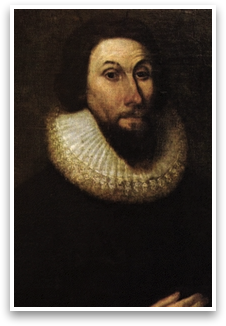
John Winthrop
John Winthrop's famous sermon "A Model of Christian Charity" follows the typical Puritan model of Exposition and Application as he draws upon his skill and training as a lawyer to craft the rhetoric.
Drawing upon the language of covenant theology, Winthrop draws a necessary connection between the religious world and the political/social world.
Winthrop interprets the Puritan journey typologically, and his understanding of America as an exemplar (i.e. the "city on a hill") is an enduring American myth. Like Bradford, he interprets history through the lenses of God's providence.

Themes and Facts
- Son of a prosperous lawyer.
- A Cambridge-educated Puritan.
- Unlike Bradford, Winthrop was not a Separatist.
- A lawyer by trade.
- Left England for both economic and religious reasons.
- For twenty years Winthrop was governor of the Massachusetts Bay Colony.
- Renowned for his sermon "A Model of Christian Charity."
Study Questions
- "A Model of Christian Charity" is a typical Puritan sermon in terms of its structure. What is the organizational structure of this sermon? How do you see Winthrop's training as a lawyer manifest itself?
- Winthrop often draws upon the metaphor of the human body. Why? What is the relationship between the human body and the Christian community?
- Winthrop's appropriation of the phrase "city on a hill" is used by political figures to this very day. Why is that the case? How has this understanding of America contributed to our self-conception?
John Winthrop's sermon, "A Model of Christian Charity," displays not only Winthrop's rhetorical and homiletical genius, but also demonstrates the high ideals to which the Puritan settlers aspired regarding establishment of a model Christian community.